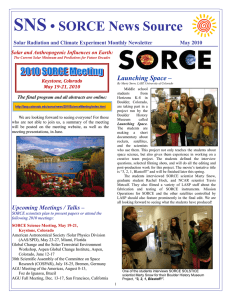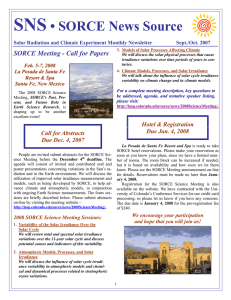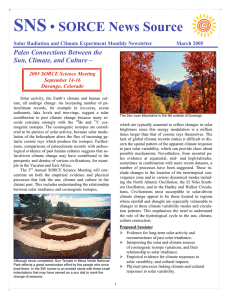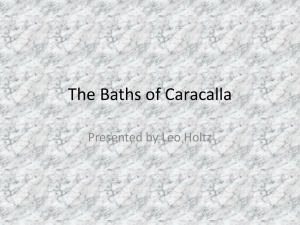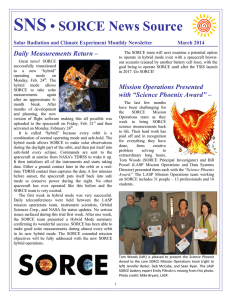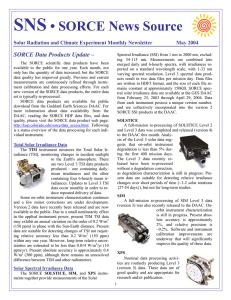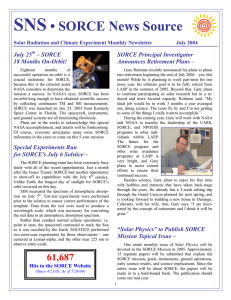SNS • SORCE News Source SORCE Principal Investigator
advertisement
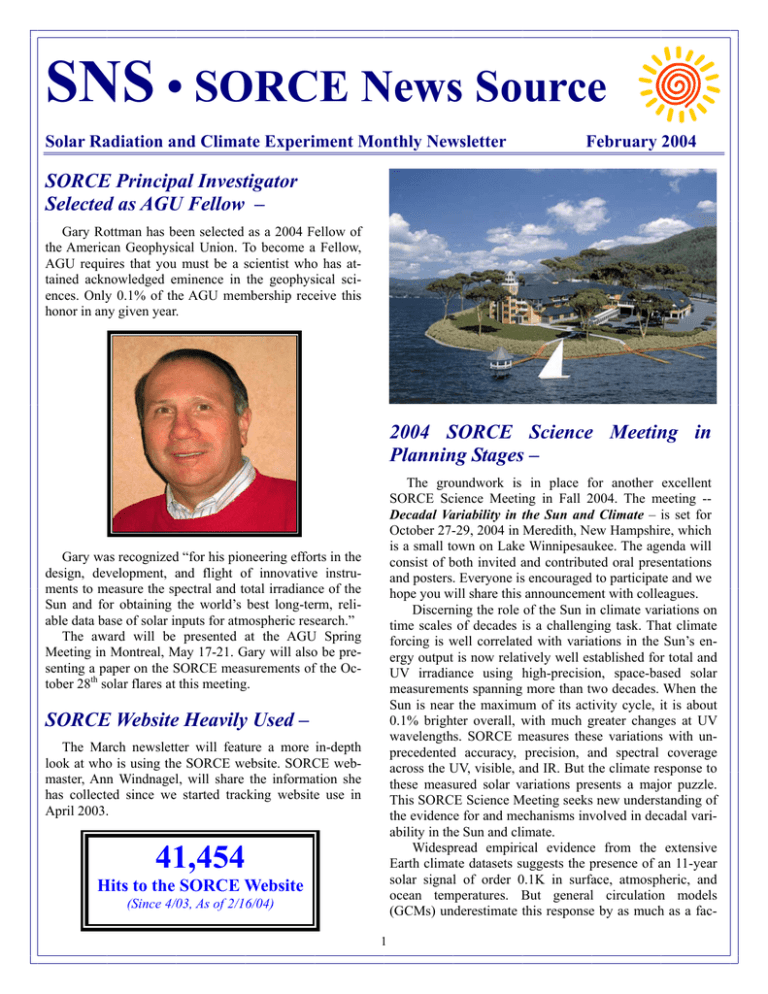
SNS • SORCE News Source Solar Radiation and Climate Experiment Monthly Newsletter February 2004 SORCE Principal Investigator Selected as AGU Fellow – Gary Rottman has been selected as a 2004 Fellow of the American Geophysical Union. To become a Fellow, AGU requires that you must be a scientist who has attained acknowledged eminence in the geophysical sciences. Only 0.1% of the AGU membership receive this honor in any given year. 2004 SORCE Science Meeting in Planning Stages – The groundwork is in place for another excellent SORCE Science Meeting in Fall 2004. The meeting -Decadal Variability in the Sun and Climate – is set for October 27-29, 2004 in Meredith, New Hampshire, which is a small town on Lake Winnipesaukee. The agenda will consist of both invited and contributed oral presentations and posters. Everyone is encouraged to participate and we hope you will share this announcement with colleagues. Discerning the role of the Sun in climate variations on time scales of decades is a challenging task. That climate forcing is well correlated with variations in the Sun’s energy output is now relatively well established for total and UV irradiance using high-precision, space-based solar measurements spanning more than two decades. When the Sun is near the maximum of its activity cycle, it is about 0.1% brighter overall, with much greater changes at UV wavelengths. SORCE measures these variations with unprecedented accuracy, precision, and spectral coverage across the UV, visible, and IR. But the climate response to these measured solar variations presents a major puzzle. This SORCE Science Meeting seeks new understanding of the evidence for and mechanisms involved in decadal variability in the Sun and climate. Widespread empirical evidence from the extensive Earth climate datasets suggests the presence of an 11-year solar signal of order 0.1K in surface, atmospheric, and ocean temperatures. But general circulation models (GCMs) underestimate this response by as much as a fac- Gary was recognized “for his pioneering efforts in the design, development, and flight of innovative instruments to measure the spectral and total irradiance of the Sun and for obtaining the world’s best long-term, reliable data base of solar inputs for atmospheric research.” The award will be presented at the AGU Spring Meeting in Montreal, May 17-21. Gary will also be presenting a paper on the SORCE measurements of the October 28th solar flares at this meeting. SORCE Website Heavily Used – The March newsletter will feature a more in-depth look at who is using the SORCE website. SORCE webmaster, Ann Windnagel, will share the information she has collected since we started tracking website use in April 2003. 41,454 Hits to the SORCE Website (Since 4/03, As of 2/16/04) 1 tor of five. The GCMs account primarily for direct forcing by changing incoming total radiation and assume that the response time for climate feedback processes to this external forcing is of order 100 years. Processes and pathways not included in the GCMs may help facilitate the larger than predicted climate response to decadal solar variability. Solar variations in the UV spectrum modulate stratospheric ozone concentrations, which may couple to climate via radiative and dynamical pathways. These pathways may involve the Northern and Southern annular modes, allowing a solar signal to be amplified and reach Earth’s surface. Internal atmosphere-ocean oscillations such as the NAO and ENSO may also play a role. Clouds may expedite the feedback process, as they appear to also exhibit variability with the solar cycle. Stochastic climate variability may amplify the relatively small solar variations. Other, nonlinear, climate processes are speculated. At this SORCE Science Meeting we hope to relate current understanding of the solar variability with climate effects and potential climate response mechanisms. Topics will include: Living With a Star Science Workshop, March 23-26 – “Connecting our Dynamic Sun to the Heliosphere and Geospace” is the topic of the LWS workshop to be held at NCAR (Center Green facility) in Boulder, Colorado. The meeting will be devoted to the scientific topics that connect the Sun’s variability to the effects on Earth and near-Earth space. To get the discounted registration fee, the pre-registration deadline is Friday, February 27. For more information, the meeting website is – http://lasp.colorado.edu/sdo/meetings/. • Decadal variability in the atmosphere and coupling to climate • Decadal variability in the oceans as climate drivers • Tropical climate variability modes (ENSO) • High latitude climate variability modes (NAO/AO, PDO) • Non-linear/stochastic climate response processes • Mechanisms and modes of decadal solar variability The science program organizing committee members are Mark Baldwin from NorthWest Research Associates, Inc., Bellevue, Washington; Greg Kopp from LASP, University of Colorado; and Judith Lean from Naval Research Laboratory, Washington, DC. The abstract deadline is September 10, but you might want to put this important date on your calendar now, as well as the actual meeting dates (October 27-29). For additional information and updates on the meeting, please visit our website – http://lasp.colorado.edu/sorce/2004ScienceMeeting.html. NASA Issues SORCE Press Release Marking One-Year On-Orbit – You can see the release and other related materials at the NASA Goddard website -- Upcoming Meetings / Talks – SORCE scientists plan to present papers or attend the following 2004 meetings: Living With a Star Science Workshop, March 23-26, Boulder, Colorado AGU / CGU Meeting, May 17-21, Montreal, Canada AAS / Solar Physics Division, May 30-June 3, Denver, Colorado COSPAR Meeting, July 18-25, Paris, France SPIE – Optical Science and Technology, August 2-6, Denver, Colorado SORCE Science Meeting, October 27-29, Meredith, New Hampshire AGU Fall Meeting, Dec. 13-17, San Francisco, California http://www.gsfc.nasa.gov/topstory/2004/0219sorce.html. To submit information to this newsletter, please contact: vanessa.george@ lasp.colorado.edu 2
